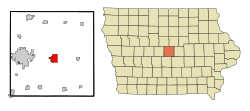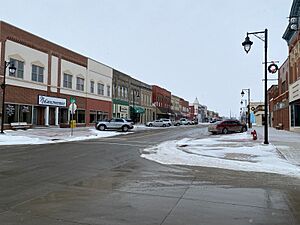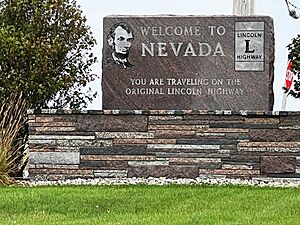Nevada, Iowa facts for kids
Quick facts for kids
Nevada, Iowa
|
|
|---|---|
 |
|

Location of Nevada, Iowa
|
|
| Country | |
| State | |
| County | Story |
| Area | |
| • Total | 5.78 sq mi (14.97 km2) |
| • Land | 5.77 sq mi (14.94 km2) |
| • Water | 0.01 sq mi (0.03 km2) |
| Elevation | 1,001 ft (305 m) |
| Population
(2020)
|
|
| • Total | 6,925 |
| • Density | 1,200.17/sq mi (463.41/km2) |
| Time zone | UTC-6 (Central (CST)) |
| • Summer (DST) | UTC-5 (CDT) |
| ZIP code |
50201
|
| Area code(s) | 515 |
| FIPS code | 19-55695 |
| GNIS feature ID | 0459461 |
Nevada (pronounced "niv-AY-duh") is a city in Iowa, USA. It is the main city of Story County. In 2020, about 6,925 people lived here. Nevada is part of a bigger area that includes Ames, Iowa, another city in Iowa. It is the second largest city in Story County. The city's name is pronounced differently from the U.S. state of Nevada.
Contents
Discovering Nevada's Past
Nevada was first mapped out in 1853. It was built along the West Indian Creek. A local settler, Mr. Thrift, named the town after his daughter, Sierra Nevada. She was named after the Sierra Nevada mountain range.
On October 11, 1853, Theodore E. and Hannah Alderman moved into the first building in Nevada. This building was very important. It served as a store, a post office, and even a courtroom. Their son, Ulysses Sherman Alderman, later became a leader in the Iowa government. Nevada has had a post office since 1854.
Historic Places in Nevada
Nevada has several old and important places. One is the Briggs Terrace Evergreen Lane Property, finished in 1879. Another is the Nevada Downtown Historic District. This area was added to the list of important historic places in 2003.
In 2019, the downtown district became part of the Main Street Iowa program. This program helps improve and preserve historic downtown areas across the United States.
Exploring Nevada's Location
Nevada is located in the middle of the United States. Its exact spot on a map is 42.019152 degrees North and -93.451775 degrees West.
The city covers a total area of about 5.08 square miles (13.16 square kilometers). Most of this area, about 5.06 square miles (13.11 square kilometers), is land. A small part, about 0.02 square miles (0.05 square kilometers), is water.
Understanding Nevada's Population
| Historical population | |||
|---|---|---|---|
| Census | Pop. | %± | |
| 1860 | 350 | — | |
| 1870 | 982 | 180.6% | |
| 1880 | 1,541 | 56.9% | |
| 1890 | 1,662 | 7.9% | |
| 1900 | 2,472 | 48.7% | |
| 1910 | 2,138 | −13.5% | |
| 1920 | 2,668 | 24.8% | |
| 1930 | 3,133 | 17.4% | |
| 1940 | 3,353 | 7.0% | |
| 1950 | 3,763 | 12.2% | |
| 1960 | 4,227 | 12.3% | |
| 1970 | 4,952 | 17.2% | |
| 1980 | 5,912 | 19.4% | |
| 1990 | 6,009 | 1.6% | |
| 2000 | 6,658 | 10.8% | |
| 2010 | 6,798 | 2.1% | |
| 2020 | 6,925 | 1.9% | |
| U.S. Decennial Census | |||
Population Changes Over Time
Nevada's population has grown steadily over many years. In 1860, only 350 people lived there. By 1900, the population had grown to 2,472. This shows how the city has developed over time.
In 2000, there were 6,658 people living in Nevada. By 2010, the population had increased to 6,798. The most recent count in 2020 showed 6,925 people. This means Nevada continues to be a growing community.
Who Lives in Nevada (2020)
In 2020, there were 6,925 people living in Nevada. The city had 2,880 households, which are groups of people living together. About 29.4% of these households had children under 18.
The average age of people in Nevada was 39.8 years. About 25.8% of the residents were under 20 years old. This shows a mix of young people, adults, and older residents living in the city.
News and Entertainment in Nevada
Local News
The Nevada Journal is the local newspaper for the city. It comes out every Thursday. It covers news about the city and the surrounding area, including sports. It is the official newspaper for the City of Nevada. Another local paper, "Story Today," is released on Wednesdays.
For bigger news, people in Nevada can read the Des Moines Register and the Ames Tribune. These newspapers provide daily national news.
Radio and Television
Nevada does not have its own radio or TV stations. However, people in Nevada can easily access radio and TV channels from nearby Ames and Des Moines.
Nevada is also mentioned in a book! It is featured in the 2017 novel Universal Harvester by John Darnielle.
Getting Around Nevada
Roads and Highways
Nevada is served by US Highway 30. This highway was once known as the Lincoln Highway, a very old and famous road across America. US Highway 30 used to go right through the middle of Nevada.
In the 1970s, a new bypass for US Highway 30 was built south of the city. This helped reduce traffic in the downtown area. Now, Iowa Highway 133 connects the city center to the new US Highway 30. Nevada also has many paved county roads that connect farms to markets.
Railroads
Nevada has a history with railroads. The Chicago and North Western Railroad used to serve the city. Today, the Union Pacific Railroad owns this line. It runs east to west, north of the main business area.
Another railroad, the Chicago, Rock Island and Pacific Railroad, also served Nevada. This line, called the "Spine Line," connected Minneapolis and Kansas City. It went through the southern part of Nevada. The Rock Island company stopped operating in 1980.
The Chicago and North Western Railroad bought the "Spine Line" later. This helped them connect better to Minneapolis and Kansas City. A new connection was built on the west side of Nevada to link the two rail lines. This new connection also required building an overpass for the old Lincoln Highway.
Since 1995, when Union Pacific Railroad bought the Chicago and North Western Railroad, train traffic has increased a lot on both lines in Nevada.
Learning in Nevada
The Nevada Community School District runs the public schools in the city. The school colors are purple and gold, and their mascot is a cub.
- Central Elementary School
- Nevada Community Middle School
- Nevada Community High School
- Nevada Community Resource Center
Famous People from Nevada
- Dayton Countryman (1918–2011), who was a top lawyer for Iowa.
- Mary Clem, a mathematician and "human computer" who worked at Iowa State University.
- Neva Patterson (1920–2010), a well-known actress.
- Paul Rhoads (born 1967), a college football coach. He used to be the head coach at Iowa State University.
- Billy Sunday, a famous baseball player and religious speaker.
- Michael Wacha, a baseball player for the San Diego Padres.
- John Scott, a Civil War Colonel and Lieutenant Governor of Iowa from 1868 to 1870.
See also
 In Spanish: Nevada (Iowa) para niños
In Spanish: Nevada (Iowa) para niños




